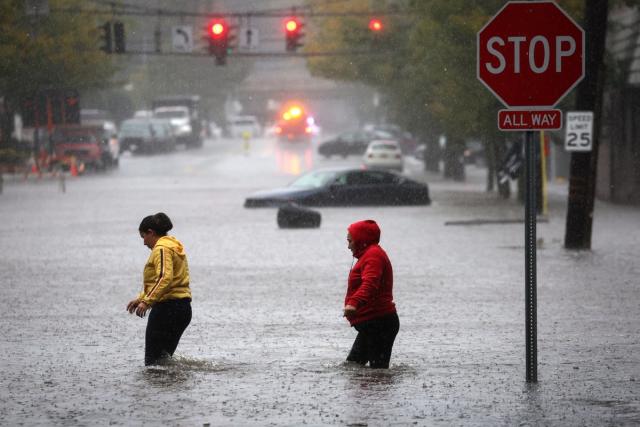Flooding closed roads, disrupted subway service and flooded basements in the New York City area as “dangerous and life-threatening” rainfall overwhelmed the concrete expanse during the Friday morning commute.
A month’s worth of rain – more than 4 inches – fell over parts of Brooklyn in just three hours Friday morning. Intense rainfall rates of 1 to 2 inches an hour were falling across the New York tri-state area and were expected to continue through Friday evening.
Heavy rainfall was also flooding basements in New York City Friday morning, according to New York City emergency management. It also overwhelmed sewers and flooded roads in Brooklyn, Manhattan, Queens and Hoboken, New Jersey, forcing road closures there, authorities announced.
"A flash flood warning is in effect" pic.twitter.com/fSRHLZ07Gi
— Andre Forbes (@andref1989) September 29, 2023
More than 8.5 million people were under flash flood warnings early Friday across portions of New York and New Jersey the region’s National Weather Service office said. A widespread 1 to 2 inches of rain had already fallen across the warning area since midnight, with much more to come.
Millions of New Yorkers received alerts from the weather service Friday morning warning of a “dangerous and life-threatening situation” with a “considerable” risk of flash flood damage.
About 1.19 inches of rain fell at John F. Kennedy International Airport in Queens over an hour early Friday and as of 10 a.m., the major travel hub had recorded over 4 inches of rainfall since midnight according to the weather service.
The flood threat will impact roughly 25 million people across the Northeast Friday, and the New York tri-state area is facing a Level 3 of 4 “moderate” risk for flash flooding, the National Weather Service warned.
The urban flood threat prompted officials in New York City to issue a travel advisory starting at 4 a.m. Friday through 6 a.m. ET Saturday, warning of potentially “widespread travel impacts” during the morning commute.
“We urge New Yorkers to prepare for heavy rain and potential flooding throughout Friday and Saturday morning,” NYC Emergency Management Commissioner Zach Iscol said. “All New Yorkers need to exercise caution. If you must travel, consider using public transportation and allow for extra travel time, and if you must drive, do not enter flooded roadways.”
Central New Jersey northward to Manhattan, Long Island in New York and into southern Connecticut and the Hudson Valley are expected to see the highest amounts of rain.
Meanwhile, neighboring cities of Philadelphia and Boston could see up to 2 inches of rain while Hartford could collect up to 3 inches or more. Overall, widespread rainfall totals between 2 and 4 inches are expected, but those totals could increase to between 5 and 8 inches in some areas.
New York City subways to remain operational
Ahead of the expected heavy rainfall, the MTA kept all services at its more than 470 stations running Friday.
“There may be impacts to service, but our plan is to run service everywhere the MTA operates,” MTA Chair and CEO Janno Lieber said during a news conference Thursday, acknowledging that water will inevitably creep into some facilities.
The MTA has installed drain covers, Lieber said, and will be deploying pump trains and sending crews to strategic locations throughout the transit system.
The public transit network has also prepared additional buses on standby to provide supplemental service in case the rail system is hindered by the storm, Lieber added.
The flooding impacts may also be exacerbated by the final supermoon of this year, which will occur Friday morning. The event typically creates more extreme tidal cycles that could increase the flood risk along the East Coast.
In anticipation of that, coastal flood advisories extend more than 300 miles from Bridgeport, Connecticut, through Virginia Beach.
Up to a foot of inundation above ground level is expected in low-lying areas near shorelines and tidal waterways, according to the National Weather Service.
Flooded Bushwick pic.twitter.com/nlTiaHxWIF
— Ian Ford (@ianfford) September 29, 2023

